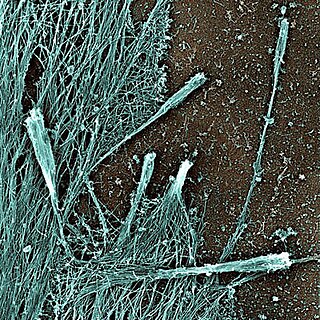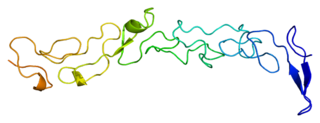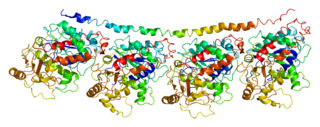Related Research Articles

An axon, or nerve fiber, is a long, slender projection of a nerve cell, or neuron, in vertebrates, that typically conducts electrical impulses known as action potentials away from the nerve cell body. The function of the axon is to transmit information to different neurons, muscles, and glands. In certain sensory neurons, such as those for touch and warmth, the axons are called afferent nerve fibers and the electrical impulse travels along these from the periphery to the cell body and from the cell body to the spinal cord along another branch of the same axon. Axon dysfunction can be the cause of many inherited and acquired neurological disorders that affect both the peripheral and central neurons. Nerve fibers are classed into three types – group A nerve fibers, group B nerve fibers, and group C nerve fibers. Groups A and B are myelinated, and group C are unmyelinated. These groups include both sensory fibers and motor fibers. Another classification groups only the sensory fibers as Type I, Type II, Type III, and Type IV.

L1, also known as L1CAM, is a transmembrane protein member of the L1 protein family, encoded by the L1CAM gene. This protein, of 200-220 kDa, is a neuronal cell adhesion molecule with a strong implication in cell migration, adhesion, neurite outgrowth, myelination and neuronal differentiation. It also plays a key role in treatment-resistant cancers due to its function. It was first identified in 1984 by M. Schachner who found the protein in post-mitotic mice neurons.

Laminins are a family of glycoproteins of the extracellular matrix of all animals. They are major components of the basal lamina, the protein network foundation for most cells and organs. The laminins are an important and biologically active part of the basal lamina, influencing cell differentiation, migration, and adhesion.

Filopodia are slender cytoplasmic projections that extend beyond the leading edge of lamellipodia in migrating cells. Within the lamellipodium, actin ribs are known as microspikes, and when they extend beyond the lamellipodia, they're known as filopodia. They contain microfilaments cross-linked into bundles by actin-bundling proteins, such as fascin and fimbrin. Filopodia form focal adhesions with the substratum, linking them to the cell surface. Many types of migrating cells display filopodia, which are thought to be involved in both sensation of chemotropic cues, and resulting changes in directed locomotion.
A neurite or neuronal process refers to any projection from the cell body of a neuron. This projection can be either an axon or a dendrite. The term is frequently used when speaking of immature or developing neurons, especially of cells in culture, because it can be difficult to tell axons from dendrites before differentiation is complete.

Thrombospondin 1, abbreviated as THBS1, is a protein that in humans is encoded by the THBS1 gene.

Laminin subunit gamma-2 is a protein that in humans is encoded by the LAMC2 gene.

Laminin subunit gamma-1 is a protein that in humans is encoded by the LAMC1 gene.

Laminin subunit beta-1 is a protein that in humans is encoded by the LAMB1 gene.

Tubulin alpha-1A chain is a protein that in humans is encoded by the TUBA1A gene.

Contactin 1, also known as CNTN1, is a protein which in humans is encoded by the CNTN1 gene.

Contactin-2 is a protein that in humans is encoded by the CNTN2 gene.

Receptor-type tyrosine-protein phosphatase mu is an enzyme that in humans is encoded by the PTPRM gene.

Laminin subunit beta-2 is a protein that in humans is encoded by the LAMB2 gene.

RhoG is a small monomeric GTP-binding protein, and is an important component of many intracellular signalling pathways. It is a member of the Rac subfamily of the Rho family of small G proteins and is encoded by the gene RHOG.

Laminin subunit gamma-3 also known as LAMC3 is a protein that in humans is encoded by the LAMC3 gene.

Laminin–111 is a protein of the type known as laminin isoforms. It was among the first of the laminin isoforms to be discovered. The "111" identifies the isoform's chain composition of α1β1γ1. This protein plays an important role in embryonic development. Injections of this substance are used in treatment for Duchenne muscular dystrophy, and its cellular action may potentially become a focus of study in cancer research.

Cellular adhesions can be defined as proteins or protein aggregates that form mechanical and chemical linkages between the intracellular and extracellular space. Adhesions serve several critical processes including cell migration, signal transduction, tissue development and repair. Due to this functionality, adhesions and adhesion molecules have been a topic of study within the scientific community. Specifically, it has been found that adhesions are involved in tissue development, plasticity, and memory formation within the central nervous system (CNS), and may prove vital in the generation of CNS-specific therapeutics.

Neurotubules are microtubules found in neurons in nervous tissues. Along with neurofilaments and microfilaments, they form the cytoskeleton of neurons. Neurotubules are undivided hollow cylinders that are made up of tubulin protein polymers and arrays parallel to the plasma membrane in neurons. Neurotubules have an outer diameter of about 23 nm and an inner diameter, also known as the central core, of about 12 nm. The wall of the neurotubules is about 5 nm in width. There is a non-opaque clear zone surrounding the neurotubule and it is about 40 nm in diameter. Like microtubules, neurotubules are greatly dynamic and the length of them can be adjusted by polymerization and depolymerization of tubulin.
Cagla Eroglu is a Turkish neuroscientist and associate professor of cell biology and neurobiology at Duke University in Durham, North Carolina and an investigator with the Howard Hughes Medical Institute. Eroglu is also the director of graduate studies in cell and molecular biology at Duke University Medical Center. Eroglu is a leader in the field of glial biology, and her lab focuses on exploring the role of glial cells, specifically astrocytes, in synaptic development and connectivity.
References
- ↑ Hynes, R. O.; Lander, A. D. (1992). "Contact and adhesive specificities in the associations, migrations, and targeting of cells and axons". Cell. 68 (2): 303–322. doi:10.1016/0092-8674(92)90472-O. PMID 1733501. S2CID 19327715.
- ↑ Witt, D. P.; Lander, A. D. (1994). "Differential binding of chemokines to glycosaminoglycan subpopulations". Current Biology. 4 (5): 394–400. doi:10.1016/S0960-9822(00)00088-9. PMID 7922353. S2CID 34658474.
- ↑ Ivins, J. K.; Colognato, H.; Kreidberg, J. A.; Yurchenco, P. D.; Lander, A. D. (1998). "Neuronal receptors mediating responses to antibodyactivated laminin-1" (PDF). The Journal of Neuroscience. 18 (23): 9703–9715. doi:10.1523/JNEUROSCI.18-23-09703.1998. PMC 6793292 . PMID 9822731.
- ↑ Calof, A. L.; Campanero, M. R.; O'Rear, J. J.; Yurchenco, P. D.; Lander, A. D. (1994). "Domain-specific activation of neuronal migration and neurite outgrowth-promoting activities of laminin". Neuron. 13 (1): 117–130. doi:10.1016/0896-6273(94)90463-4. PMID 8043273. S2CID 22104247.
- ↑ Calof, A. L.; Lander, A. D. (1991). "Relationship between neuronal migration and cell-substratum adhesion: Laminin and merosin promote olfactory neuronal migration but are anti-adhesive". The Journal of Cell Biology. 115 (3): 779–794. doi:10.1083/jcb.115.3.779. PMC 2289183 . PMID 1918163.
- ↑ Lander, A. D.; Fujii, D. K.; Reichardt, L. F. (1985). "Purification of a factor that promotes neurite outgrowth: Isolation of laminin and associated molecules". The Journal of Cell Biology. 101 (3): 898–913. doi:10.1083/jcb.101.3.898. PMC 2113739 . PMID 4030898.
- ↑ Lander, A. D.; Fujii, D. K.; Reichardt, L. F. (1985). "Laminin is associated with the "neurite outgrowth-promoting factors" found in conditioned media". Proceedings of the National Academy of Sciences of the United States of America. 82 (7): 2183–2187. Bibcode:1985PNAS...82.2183L. doi: 10.1073/pnas.82.7.2183 . PMC 397517 . PMID 3856891.